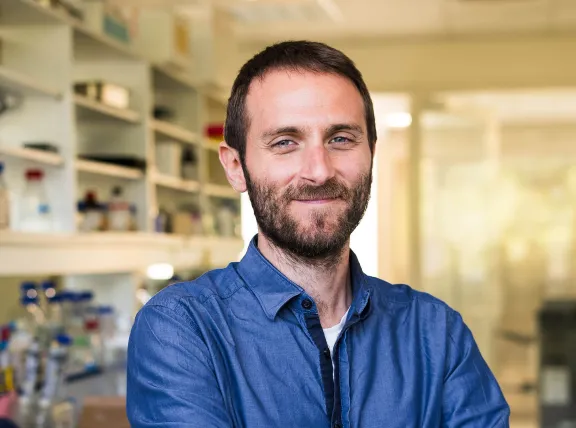Stéphane Bugeon From wakefulness to sleep, how do we adapt to changes in brain state?
Stéphane Bugeon, Inserm researcher, head of the « Neural circuits and sensory coding » team, Institut de neurobiologie de la Méditerranée (Inmed), Marseille
- 2024 • Impulscience

The brain continually adjusts its responses to internal and external stimuli. In this context, Stéphane Bugeon is decoding how particular neurons, the inhibitory interneurons, adapt their activity according to the state of the brain, such as vigilance or sleep. By combining advanced neuronal imaging and genetic techniques, the researcher is shedding light on new facets of sensory perception and brain mechanisms.
How does the brain adapt its responses to stimuli?
Our brain is constantly adapting, moving from one internal state to another, such as wakefulness, alertness or sleepiness. These changes are accompanied by major fluctuations in neuron activity, which in turn influence our ability to process the sensory information we receive and make appropriate decisions. For example, a person who is asleep will not react in the same way to ambient noise as if they were awake.
The brain's ability to adapt is regulated by a complex network of nerve cells in the cerebral cortex, including inhibitory interneurons. These send messages to other neurons in the cortex to adapt the brain's response to various stimuli.
Interneurons are divided into numerous subtypes, each with specific functions. There are 60 different interneurons in the visual cortex alone, the part of the brain that processes visual stimuli. However, it is still difficult to understand how each subtype contributes to cerebral activity in a brain in action. In other words, which subtype does what.
Promising innovations in neuroscience
Stéphane Bugeon and his team are exploring how the brain adapts its responses. Using a combination of advanced neural imaging and genetic techniques, the researchers mapped the different types of interneurons in the mouse's visual cortex and observed their activity.
Previous research has shown that interneuron activity varies according to the animal's internal state. Stéphane Bugeon's multidisciplinary work goes further, revealing that this variation is dictated directly by the interneuron genes. In other words, it is possible to predict from their genetic identity how the interneurons will react according to the internal state in which the animal finds itself. All that remains now is to understand the operating mechanisms underlying this discovery.
From the visual cortex to the whole brain
Thanks to Impulscience®, Stéphane Bugeon is going to study whether the relationship between the state of the brain and the activity of interneurons, demonstrated in the visual cortex, is generalized to the whole cortex. To gain a better understanding of the mechanisms that modulate interneuron activity, he will be looking at the role of acetylcholine (ACh), a neurotransmitter that is important for regulating brain state. The aim is to determine whether all interneuron subtypes respond in the same way to ACh or whether differences explain their variations in activity. Finally, the researcher will investigate whether signals from the thalamus, the part of the brain that transmits sensory information to the cortex, interact with ACh in the cortex to spatially organize the signals associated with internal states.
This ambitious project combines cutting-edge imaging and genetic tools and promises major advances in our understanding of the brain. These discoveries will open up new avenues for exploring how inhibitory interneurons influence sensory perception according to brain state.
Stéphane Bugeon in a few words
Stéphane Bugeon completed his PhD at the Institut de Biologie du Développement in Marseille. During his post-doctoral stay at University College London (United-Kingdom) between 2018 and 2023, he focused on the genetic and functional diversity of interneurons in the cortex. He became an Inserm research in 2023, and currently heads the "Neuronal Circuits and Sensory Coding" team at the Institut de Neurobiologie de la Méditerranée (Inmed), Marseille.






